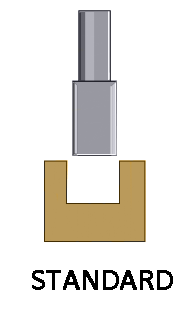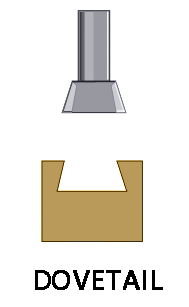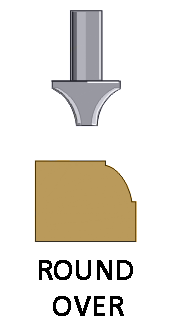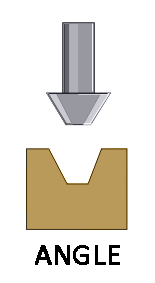Kinds of Router Bits
Published by Priscilla on 7th Jul 2014
Routers are widely considered the most useful power tool any carpenter can own. With the right bit, you can cut anything from a square groove to a complicated edge treatment in a single pass. Router bits come in all shapes and sizes, and so do routers. Hand-held routers are suitable for casual hobby woodworkers, while more heavy duty models are great for professional carpenters. Routers are particularly popular with cabinetmakers and anyone who does decorative work as they are particularly good at both edging and cutting interiors.
The key to a router is the bit. Bits do all the work, and without a bit, the router is little more than a heavy weight. You can do things with specialty bits can do things that are simply impossible with any other woodworking tool.
Routers merely spin and lower the bits into the wood. The varied effects you can achieve with a router are determined by the shape and quality of the bits you use.
When routers cut, they use the side of the bit. A hand-held router includes a variable-speed electric motor with a collet, a kind of chuck that holds the bit, mounted above a sole plate that the router rests on when in use. There are two basic types of hand-held routers: plunge routers and fixed routers. When using a fixed router, the operator sets the desired depth before the router is turned on. The bit on a fixed router protrudes below the plate even before you start cutting. This means that has to come in from the side of the piece being worked, and so can only work along the edges of the piece. A plunge router, on the other hand, can drill downward as well as cut along the side. It can make either interior cuts or exterior cuts.
Three Basic Types of Router Bits
There are three basic types of router bits:
Type Use
Fluted Cutters Edging and Trimming
Profile Cutters Trimming and Shaping
Helical Cutters Drilling, Trimming, and Shaping
The word “fluted” refers to the cutting edge of the bit. Fluted cutters are used for relatively simple cuts, producing a fairly smooth and straight cut. Profile cutters produce complicated edging that is almost impossible to do without a router. Helical cutters are most often used with plunge routers. It is their helical edge that lets them drill into soft materials.
That being said, there are many different kinds of router bits that fit into these three categories. Each kind of bit is designed for a different kind of work. The exact kind of router bit you need will depend on the task you are undertaking.

Straight/Dado Router Bits
Straight router bits are the most commonly used router bits. They are useful for making straight cuts and for hollowing out particular areas of your material. Straight bits can also be used to cut grooves for tongue-in-groove fasteners. In order to take full advantage of a straight router bit, a carpenter should consider a plunge router.

Joinery Bits
A joinery bit is used for making joints, or connections, between two pieces of wood. For example, they can be used to cut interlocking edges when making drawers or cabinets. A joinery bit produces a channel that is wide at the bottom and slants inward toward the top. Because of their geometry, joinery bits are usually used in fixed routers.

Flush Trim
Flush Trim Routing Bits
Flush trim routing bits are piloted bits, having a ball bearing that is the same size as the cutting radius of the bit. This kind of routing bit is designed to enable two edges to come together smoothly. They are also used to create identical parts, ensuring that the parts will all fit together. They are ideal for creating smooth joins.

Rabbeting Router Bits
Rabbeting bits are designed to cut square notches in the edge your material. They do this by making simultaneous horizontal and vertical cuts that intersect at a ninety-degree angle. They are piloted bits, meaning that they use gall bearings to guide the bit and ensure a smooth, even cut. One nice thing about rabbeting bits is that they allow you to minimize costs because the same routing bit can be used to produce different rabbet dimensions.

Chamfer Routing Bits
Chamfer routing bits are used to create beveled edges on any kind of material. They are useful for decorating the edges of objects such as wooden doors and panels. These bits are also used in joinery. It is much easier to join beveled edges than flat ones because the bevels provide a guide.


Edge Forming Router Bits
Edge forming router bits are the ideal for creating decorative edges. There are many varieties of edge forming router bits, and the choice you make will depend on the effect you want to achieve.
- Roundover bits are used to cut rounded edges.
- Cove routing bits are used for cutting a concave circle.
- Ogee bits will produce an S-curve along the edge of the piece you are trimming. They are very useful when creating decorative edge-work.

Raised Panel Bits
Raised panel bits are used to decorate wooden door panels, and they work in conjunction with stile and rail router bits to create different profiles on material. These router bits are available in a vertical and horizontal configuration to give users a higher degree of versatility for woodworking projects. Many users consider the vertical configuration to be safer than the horizontal one, though the latter configuration is ideal for arched or cathedral doors.

Stile and Rail Bits
Stile and rail router bits actually have two functions. They are popularly used for cutting decorative edges. They are also used for cutting a panel slot for frame assembly. In fact, they can perform both tasks simultaneously. These bits come as a set of two and they can be combined to create both the horizontal rail profile and the vertical stile profile. They may be specialized, but they are very useful when working on doors.
